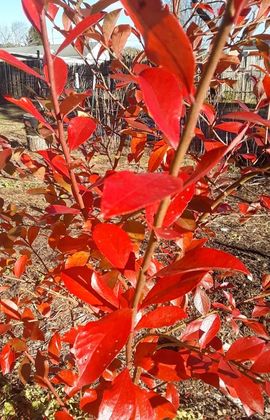Don’t Despair, Plant Lovers! Native Plants Offer Winter Interest
By Torry Nergart, Conservation Easement Manager.
This story originally appeared in the Transylvania Times.
Winter can seem dreary at times. To the gardener, it seems like the only thing to do is chores and more chores. For any plant lover, the season may appear to be the least interesting time of the botanical year. But there is, of course with nature, always a lot going on “behind the scenes” and plenty of that can be incorporated into your native plants garden. Consider having a grouping of one or more of these plants to give the fourth season interest, which could go miles towards helping get you through the long cold.

If I were to give my first thought/best thought on recommending a native plant for winter, I’d say the common Witch Hazel shrub (Hamamelis virginiana). The genus name refers to the two botanical elements going on in the winter, and means “together with fruit” – a reference to the fact that the previous year’s fruit (that explode when ripe) are on the branch at the same time the thread-like flowers are open – right about now. If you’ve hiked any of the several wet coves in Pisgah, you’ve likely encountered this plant. Finding it in the winter in its natural element, with the long sunlight striking the clusters of yellow flowers, is a real uplift to the seemingly uniform grey. Bringing the plant home is quite easy. There are several cultivars that have improved floral displays, and the plant can take advantage of that semi-shady spot you’ve been waiting to fill.
Winter gardening also drives us to think outside of regular floral displays and give thought to plants that gain their interest when all others are losing theirs. Choosing a native plant with a highly patterned or colorful bark brings warmth to the cold. The Silky Dogwood (Cornus amomum) with its maroon twigs and branches is an excellent option to plant en masse and coppice, to keep the color on display. The crowded branching can be formed into a hedge or other linear feature in the garden, and later after the winter interest fades, this plant will produce large clusters of white flowers followed by an indigo fruit which wildlife will devour.
Now that we have both streaks of color and blossoms in our winter garden, perhaps adding an evergreen would make a good backdrop to the display. The American Holly (Ilex opaca) can be clipped into holiday-inspired shapes or left open-grown make an overall conic form with reaching branches full of berries. You’ll want to plant a male tree for every three female trees to get that Yule-season look, and the plant does have cultivars with dense red fruit clusters, and even comes in yellow berries. And speaking of berries, if you like to get double-duty out of your garden plants, the humble blueberry bush provides excellent late foliage color, the bright red leaves hanging on much longer than the overall fall leaf display.

I hope these few suggestions amongst the many out there in the big, botanical world will bring you some brightness and cheer during the winter. I’ve made them using all Western North Carolina native species for good reason. When you garden is filled with native plants, you’re not just inviting the plants to your home, you’re inviting the birds to partake of the berries and nest in the branches. You’re bringing in a veritable buffet of juicy caterpillars for those birds to thrive with – remember, non-native plants like Crepe Myrtle are host to no insects, so no food. They’re as sterile as a fake plastic tree in a bank lobby! The bugs that need native plants for food are often quite ‘in check’ by predators (aka wild birds) and therefore don’t ruin the plant display. Native plants require less care or doting, as they are adapted to here and have all the methods to thrive here. Give native plants a try!
Torry Nergart is the conservation easement manager for Conserving Carolina.